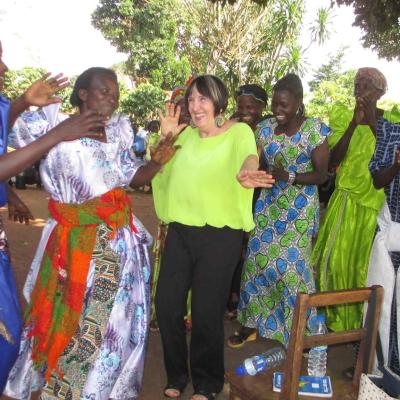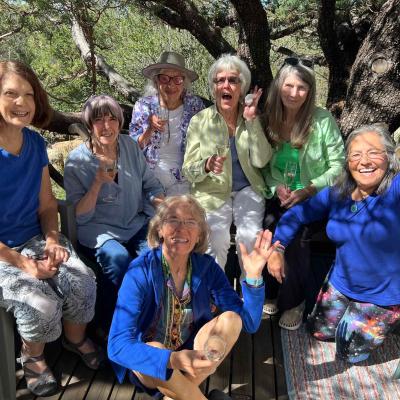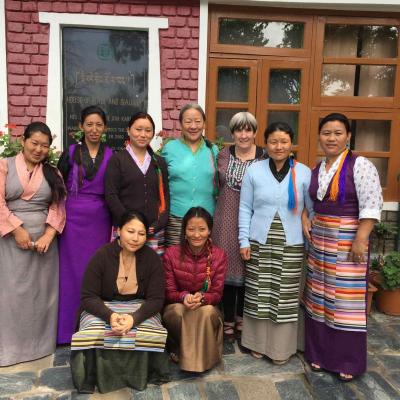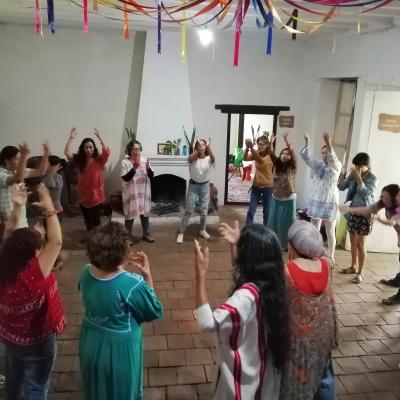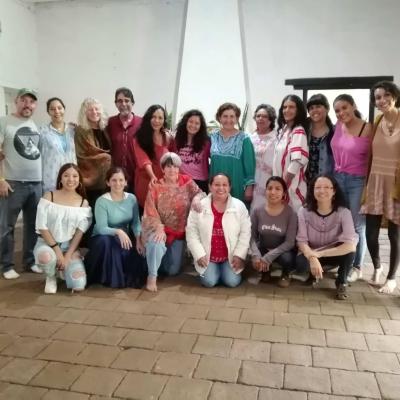Narratives and Neural Winds
© 1996 by Sharon G. Mijares, Ph.D.
(Originally published in Somatics: Journal of the Mind/Body Arts and Sciences)
The inner being of a human being is a jungle.
Sometimes wolves dominate,
sometimes wild hogs.
Be wary when you breathe!
At one moment vicious qualities move in hidden ways;
the next moment gentle, generous qualities, like Josephs,
pass from one nature to another.
A bear begins to dance.
A goal kneels!
A portion of Rumi's poem "A Goal Kneels" from Delicious Laughter translated by Coleman Barks
Narratives are woven into the fabric of the body. When the center of attention is focused from lofty cerebral watchtowers, we fail to hear and feel these narratives and mythological fragments whispering within the neural pathways of our beings. Our breath is held, our sensitivities dimmed and fixated by limited attention. The body is alive with archetypical stories waiting to be acknowledged. Archetypes are psychic structures containing biologically related patterns of behaviors consisting of certain qualities and expressions of being. They are related to the instinctive life forces motivating the world's mythological stories.
The ability to hear and feel the sub-personalities, fragmented self parts and archetypal forces related with life narratives is greatly enhanced by breathing practices. Breath therapies help to release the tension stored in the respiratory musculature. This has a powerful effect upon the psychophysiology of the breather as it stimulates the neural system. The breather then begins to experience increased energy moving through the blocks and character armoring.
Eastern and Middle-Eastern spiritual disciplines have utilized the breath as a healing process for over 3,000 years (Joshi, 1977; Mijares, 1991; Mueller, 1962; Yati, 1979). Only recently have Westerners discovered its potential for awakening spiritual potentials, releasing repression, healing stress and trauma (Grof, 1988; Reich, 1948). Wilhelm Reich specifically utilized the breath to free state-bound life energy and to invoke emotional release and healing.
Reich determined this repressed energy flow to be part of humanity's armor and believed that the repression was passed on from generation to generation. He utilized the ability of the breath to enable the human musculature to relax its binding grip. Reich hypothesized that many if not all of our neuroses were evidenced in the inability to breathe deeply in and out in one breath. Deep breathing brings us to fuller life.
So why did the Sufi poet and mystic Rumi caution to,"Be wary when you breathe"? What happens when the breath is focused and begins to move through the neural networks and channels of the body-mind? Neural winds are increased. They stimulate cellular memories, primal, instinctual energies and awaken the body-mind from its unconscious slumber (Thurman, 1994; Washburn, 1994). Memory is inherent within the genes and cellular structures of DNA. This memory contains the stories of our genetic ancestors and those of the collective unconscious. These memories also contain dramas depicting human pathos. They are teeming with narratives of destruction, power and beauty.
Both Sigmund Freud and Carl Jung acknowledged that early life traumas could cause a certain "childhood amnesia" (Jung, 1964) and that retrieval of the lost memories had the potential of freeing the natural spontaneity and creative power of the self that had been blocked in traumatic experience. Recovery of the authentic nature is at the crossroad where a split occurred between cerebral and body awareness and affect is the bridge. Do we ever experience a feeling without a bodily sensation? Feelings and the body are intimately connected and essential for healing of the mind-body split. The current controversy over recovered memories only serves to divert from the topic of sexual abuse to the innocent . Instead, the argument concerns the reliability of cognitive processes. Once again, the focus is in the head and the sacredness of the body dishonored.
In his text World religions: From ancient history to the present (1971) Geoffrey Parrinder describes how ancient Greek mythologies referenced a splitting between male and female, mind and body. The myths described the marriage of Sky and Earth. Their union safeguarded fertility. Next the cosmologies described the forcing apart of Sky and Earth. They were no longer united in sexual union. Parrinder notes that this was the beginning of rationalization. Attention was withdrawn into the cerebral watchtower and for the most part the soul dropped into the unconscious body-mind.
My own narrative was initiated by turning to Eastern breathing practices after years of literary research and spiritual studies.The egoic self in its cerebral control tower had acknowledged its limitations. Cells began to quiver, muscles quaked and messenger molecules began to travel through the neural circuitry of my body. The breathwork had stimulated the body's innate intelligence as messenger molecules activated nodal points in the neural information system of my body consciousness. The first indications of a deep narrative structure manifested in a dream intimating that neglected self-parts and archetypal forces were hidden in cellular blocks, darkened shadows and power centers within the fibers of the body. A year later spontaneous pre-verbal and primal sounds began to manifest. The beings residing within the unconscious tissues of my body-mind were insistent upon making their stories known.
I had developed a strong cognitive sense of self as a survival skills. This ego-state could reason out, understand or rationalize almost any person or circumstance. The younger ego-state(s) had split off and was contained, isolated in her own cellular space. The cerebral and feeling selves were now cognizant of each other, but soul retrieval was impaired by the archetypal, wrathful force at the gate. I knew it to be an archetype for it lacked the tone of human presence.
I soon learned that these strange manifestations were familiar expressions of healing and emergence syndromes recognized by spiritual teachers of Eastern and Sufi orientations and also by depth psychotherapists using trance processes. Depth psychologist Stephen Gilligan writes about the break between the egoic cognitive self in the head and the archetypal, feeling self(ves) in the body (Gilligan, 1996). His Self-Relations psychotherapy is focused upon healing the split in the relational field. Sufi teacher Saadi Neil Douglas-Klotz recommends Middle-Eastern breath and mantric sound practices to enhance awareness of the depths of the self(ves) in the belly (1995). In Sufism the subconscious self(ves) is called the nafs. Carl Jung theorized that a neural substrate could contain a form of archetypal consciousness (1969). The body is alive with sub-personalities and archetypal powers.
I was becoming increasingly aware of a narrative suggestive of soul retrieval as an embodied process. There was an immense split between the cognitive egoic self in the head and the beings manifesting in my body. A somatic sensation was often associated with a very young child making pre-verbal sounds to herself. She was alone, hiding in non-integrating neural circuits within my body. Often her presence was accompanied by intense growls of warning from another bodily space nearby. Through these somatic experiences, I intuited that a creature from archetypal depths was blocking the entrance to her dwelling place. I felt like a medium channeling the voices of fragmented parts of myself because my vocal cords could be used by ego-states totally separate from my own. Her story and images were unavailable to higher cerebral processes; they were locked in the limbic system of the body-mind. My sensory experience was that a muscular lock in the neck kept her story from flowing into the amgydala, the processor of emotional memory.
This conflict was measured in a biofeedback laboratory with electromyograph (EMG) electrodes on the paraspinals. One side began at baseline reading of 1.31uv, the other side was 10.31uv. As my trance deepened the laboratory experimenter moved into close territorial range and an archetypal force immediately surfaced and growled. In a split second microvolts jolted from 1.31uv and 10.31uv to 18.25uv on both electrodes (Mijares, 1995). This was an intense experience for both subject and experimenter. My subjective experience was that I was very near the activation of traumatic memory as I responded to both outward and inward influences. The dragon at the gate between the body mind and the cerebral self quickly responded to block the event. This experience equated to what is called soul retrieval work. But she was not off in an imagined cave or cloud somewhere; she was within my body.
Scientists are beginning to discover that the body-mind is a tapestry woven with rich communication systems. Research scientists Gerson, Kirchgessner and Wade (1994) describe a "highly complicated independent nervous system that influences the activity, of not only the bowel, but of the organs as well". They call this the enteric nervous system, a brain in the gut. This system sends and receives messages, just as the brain in the head does. It has many of the same messenger molecules. The enteric nervous system can produce endorphins giving feelings of well-being. Is this an indication of a shift in the direction that scientists had previously imparted and will academic textbooks be changed to acknowledge the inherent intelligence of the body? Perhaps it is time to make a shift from the locus of awareness and control being solely in our heads to one that includes being centered in our bodies. Martial artists and shamans have always known that their arts are dependent upon being centered in the belly, often referred to as the "power center.".
It's well documented that cellular structures and muscular armoring hold repressed emotions within the body-mind. Emotions and associated memories are often released through body and breath therapies. But the narratives arising from these releases are often confining. They are based upon pathological views of psychospiritual experience. The individual becomes a victim or a survivor recovering from trauma. These life stories are limited and the characters are often frozen in the drama. In this experience the perpetrator continues to abuse via resistances and self-sabotaging behaviors. Recovery of the authentic nature is the place where true healing takes place.
A human being is much more than a traumatic event. New narratives need to be written which include psyche and soma while acknowledging the pathos of the human experience as a heroic journey leading to the emergence of authenticity of self. The late mythologist Joseph Campbell said "The passage of the mythological hero...is inward--into depths where obscure resistances are overcome, and long lost, forgotten powers are revivified..." (1949, p. 29). The world's legends, folk tales and mythological stories describe various stages of the hero/heroine's journey. He writes that "Each of these bibliographies exhibits the variously rationalized theme of the infant exile and return" (p. 323). In mythological legends and fairy tales there are themes of dragons and demons guarding the entrances to caves or castles wherein reside hidden treasures, babies or young maidens. In dissociative disorders resulting from traumatic experiences the introjected perpetrator acts to conceal the knowledge that a violation has occurred. This inner saboteur contains both real and distorted archetypal power. It works to delude its victim, thereby blocking the way to the authentic expression of self. Even if trauma didn't occur in our childhood, the unconscious body-mind contains introjected repressive influences from family, friends, school experiences along with limiting social and religious ideologies.
In The hero with a thousand faces, Joseph Campbell wrote that, The unconscious sends all sorts of vapors, odd beings, terrors, and deluding images up into the mind--whether in dream, broad daylight or insanity; for the human kingdom, beneath the floor of the comparatively neat little dwelling that we call our consciousness, goes down into unsuspected Aladdin caves. There not only jewels but also dangerous jinn [Arabic word for etheric spirits] abide: the inconvenient or resisted psychological powers that we have not thought or dared to integrate into our lives. And they may remain unsuspected, or, on the other hand, some chance word, the smell of a landscape, the taste of a cup of tea, or the glance of an eye may touch a magic spring, and then dangerous messengers begin to appear in the brain. These are dangerous because they threaten the fabric of the security into which we have built ourselves and our family. But they are fiendishly fascinating too, for they carry keys that open the whole realm of the desired and feared adventure of the discovery of the self. Destruction of the world that we have built and in which we live, and of ourselves within it; but then a wonderful reconstruction of the bolder, cleaner, more spacious, and fully human life--that is the lure, the promise and terror, of these disturbing night visitants from the mythological realm that we carry within (p. 8).
The mind-body separation has reflected a loss of soul. The resulting disrespect and dissociative behaviors are evidenced in addictions, sexual abuse and violence. Even our environment, the earth body, has been neglected. Deep healing and integration can result from the unifying efforts of cognition, feeling and body. Soul retrieval is a human necessity in order to heal our current predicament.
"Be wary when you breathe" for the journey to authenticity can be a treacherous one. Introjected personalities and internalized persecutors block the path. Archetypal forces of the collective unconscious are present both enabling and preventing the retrieval of authenticity. This journey into the unconscious body-mind is not unlike a fairy tale in which the hero or heroine must pass through obstacles and face the fiery dragon in order to rescue innocence and obtain the hidden treasure. The phenomenology of my own experience and that of many others assures me that we are embodied minds. The world's mythologies offer evidence that there is a collective unconscious and that archetypal forces manifest through the genetic structure, are housed in our organs, and move through the cellular pathways within our bodies. Healing can occur individually and collectively as we begin to honor the narratives manifesting from within the embodied mind.
* * *
Body mind worker Charlie Badenhop teams with Coach Cindy Franklin. For more information go to
Seishindo.org: Charlie Badenhop and Cindy Franklin's Personal Development Workshops. Workshops for coaches, trainers, consultants, and leaders.
References
Campbell, J. (1949). The hero with a thousand faces. Princeton, New Jersey: Princeton University Press.
Douglas-Klotz, N. (1995). Desert Wisdom. San Francisco: HarperCollins.
Gerson, M.D.; Kirchgessner, A.L; & Wade, P.R. (1994). Functional anatomy of the enteric nervous system. In Leonard R. Johnson (Ed.), Physiology of the gastrointestinal tract, (pp. 381-422). (3rd ed). New York: Raven Press.
Gilligan, S. G. (1996). The relational self: The expanding of love beyond desire. In M. Hoyt (Ed.), Constructive therapies, Volume 2: Expanding and integrating effective practices. New York: Guilford Press.
Grof, S. (1988). The adventure of self-discovery. Albany: State University of New York Press.
Joshi, K. S. (1977). Pranayama: The science of yogic breathing. Delhi: Chaukhambla Orientalia.
Jung, C. J. (1964). Man and his symbols. New York: Doubleday & Co., Inc.
Mijares, S. (1995). Fragmented self, archetypal forces and the embodied mind. Dissertation Abstracts International, 56(11),B. (University Microfilms No. 9608330)
Mijares, S. (1991). The healing power of the breath. Unpublished master's thesis, Sonoma State University, Rohnert Park, CA.
Mueller, M. F. (Trans.). (1962). The Upanisads. (Part I, Part II). New York: Dover Publications, Inc.
Parrinder, G. (Ed). World religions: From ancient history to the present. New York: Facts on File Publications.
Reich, W. (1948). The function of the organism. New York: Simon & Schuster.
Thurman, R. (1994). The Tibetan book of the dead. New York: Bantam Books.
Washburn, M. (1994). Transpersonal psychology in psychoanalytic perspective. Albany: State University of New York Press.

